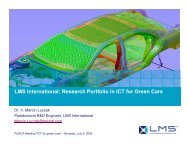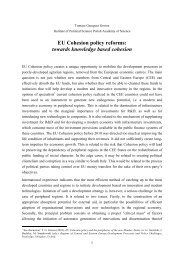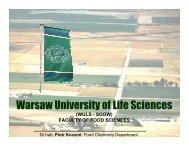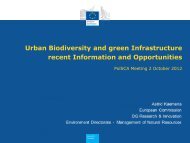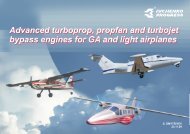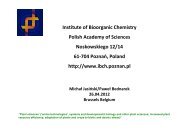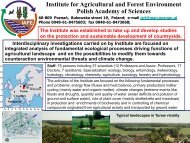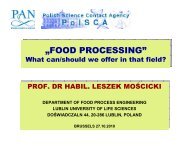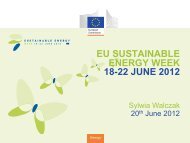Institute of Genetics and Animal Breeding Polish Academy ... - PolSCA
Institute of Genetics and Animal Breeding Polish Academy ... - PolSCA
Institute of Genetics and Animal Breeding Polish Academy ... - PolSCA
Create successful ePaper yourself
Turn your PDF publications into a flip-book with our unique Google optimized e-Paper software.
<strong>Institute</strong> <strong>of</strong> <strong>Genetics</strong> <strong>and</strong><strong>Animal</strong> <strong>Breeding</strong><strong>Polish</strong> <strong>Academy</strong> <strong>of</strong> SciencesJASTRZEBIEC near WarsawPol<strong>and</strong>Research peritinent to the role <strong>of</strong> early-life events on development <strong>and</strong> growthin animals
Research ActivityMolecular genetics, cytogenetics <strong>and</strong> immunogeneticsExperimental embryology (including embryo biotechnology) BiochemistryPhysiology <strong>of</strong> animal stress<strong>Animal</strong> behavior <strong>and</strong> welfare, behavioural geneticsAdaptation <strong>of</strong> animal genotypes to environmental conditions <strong>and</strong> productiondem<strong>and</strong>s<strong>and</strong>Introduction <strong>of</strong> the results <strong>of</strong> basic investigations into animal improvementprograms
IGAB Scientific CollaborationOur <strong>Institute</strong> cooperates with 30 national <strong>and</strong> 23 foreign scientific<strong>and</strong> research institutions <strong>and</strong> it is also an educational centre,cooperating with <strong>Polish</strong> <strong>and</strong> foreign universities.USA,Italy,Sweden,the Netherl<strong>and</strong>sRussian Federation,Ukraine,Germany,Great Britain,France,Belgium,the Czech Republic,Slovakia.
Scientific StaffAltogether there are 30 scientists working at IGAB,including 9 pr<strong>of</strong>essors, 9 assistant pr<strong>of</strong>essors (D.Sc,hablitated doctors), <strong>and</strong> 13 scientists with PhD degree.The <strong>Institute</strong> has rightto conferhigher scientific degrees(Ph.D., D.Sc.) in the field<strong>of</strong> agricultural sciences,specialisation in animalgenetics, embryology,physiology, <strong>and</strong> breeding.SCIENTIFICCOUNCIL
EducationThe <strong>Institute</strong> conducts educational activity such as Ph.D.courses - 19 postgraduate students at presentIGAB scientists supervise undergraduate students <strong>of</strong>Agricultural Universities in conducting the experimentalwork <strong>and</strong> preparing their Masters’ thesesIGAB scientists give specialised lectures at the <strong>Animal</strong><strong>Breeding</strong> <strong>and</strong> BiotechnologyDepartments <strong>of</strong> Universities,organize local <strong>and</strong> internationalconferences, workshops <strong>and</strong> courses.
IGAB PublicationsThe <strong>Institute</strong> publishes two periodicals:- English-language quarterly“<strong>Animal</strong> Science Papers <strong>and</strong> Reports”;Now included into Science CitationReports List- <strong>Polish</strong>-language periodical“Prace i MateriałyZootechniczne”.
Structure<strong>of</strong> the<strong>Institute</strong>Scientific CouncilPresident: Pr<strong>of</strong>. Marian RóŜyckiDirectorPr<strong>of</strong>. Edward DymnickiDeputy Director (research)Pr<strong>of</strong>. Lech ZwierzchowskiDeputy Director (fundamentals)Pr<strong>of</strong>. Jarosław O. HorbańczukPostgraduate StudiesHead: Dr JolantaOprzadekDepartment <strong>of</strong> ImmunogeneticsHead: Pr<strong>of</strong>. Grzegorz GrzybowskiDepartment <strong>of</strong> <strong>Animal</strong> <strong>Breeding</strong>Head: Pr<strong>of</strong>. Jarosław O. HorbańczukDepartment <strong>of</strong> Molecular BiologyHead: Pr<strong>of</strong>. Lech ZwierzchowskiResearch Coordination <strong>and</strong> ScientificLiaison UnitHead: Cyprian TomasikFinance UnitHead: W<strong>and</strong>a KarolakPublishing Unit; Editors:Pr<strong>of</strong>. Marek ŁukaszewiczDr Jerzy PiotrowskiDepartment <strong>of</strong> <strong>Animal</strong> BehaviorKierownik: Pr<strong>of</strong>. Tadeusz JezierskiAdministrative Support UnitHead: Jerzy WójcikExperimental FarmHead:Dr Wiesław JarmuŜDepartment <strong>of</strong> Molecular CytogeneticsHead: Pr<strong>of</strong>. Kazimierz JaszczakDepartment <strong>of</strong> Experimental EmbryologyHead: Pr<strong>of</strong>. Jacek ModlińskiLibraryMałgorzata Kilanowska
We are proud <strong>of</strong>Beginning <strong>of</strong> mammal cloning (Science, Nature 1958-62)Andrzej TarkowskiFirst international transfer <strong>of</strong> viable embryosJacek Modlinski, Maria CzłonkowskaFirst „artificial” interspecies hybrid Goat-SheepAndrzej Guszkiewicz, Maria CzłonkowskaPhenol method (Trizol) <strong>of</strong> RNA isolationPiotr Chomczynski, > 56,000 citationsWild forest horse (Konik Polski, Tarpan)Endocrinology <strong>and</strong> reproduction <strong>of</strong> deerSubstantial contribution to national economy – animalproduction
IGAB Experimental FarmsThe arm is an integral part <strong>of</strong> the <strong>Institute</strong>. Its principal goal isthe maintenance <strong>of</strong> farm animals (cattle, pigs, goats, sheep, hens<strong>and</strong> quails) necessary for experiments conducted in the <strong>Institute</strong>.Our animals
IGAB LaboratoriesMolecular biology, embryology, GMO, radioactiveisotopes <strong>and</strong> biochemistry.Modern animal facilities for mice <strong>and</strong> rabbits.
IGAB research projects are carried outwithin five topics groupsFunctional genomics – studies <strong>of</strong> effects <strong>of</strong> gene polymorphisms onproduction traits <strong>of</strong> farm animals – milk <strong>and</strong> meat production, <strong>and</strong>also health <strong>and</strong> reproduction traits.Biodiversity – studies <strong>of</strong> genetic markers applied to protection <strong>of</strong>genetic resources in domestic <strong>and</strong> wild animalsBiotechnology <strong>of</strong> reproduction<strong>Breeding</strong> methods applied to improvement <strong>of</strong> animal productivity,animal health <strong>and</strong> the quality <strong>of</strong> animal products.Genetic backgrounds <strong>of</strong> animal behaviourIn addition studies are carried out within 30 projects funded by the Ministry<strong>of</strong> Science <strong>and</strong> Higher Education (individual or PhD projects), <strong>and</strong> threeprojects funded by European Union
Projects funded by European Union NEWMOOD 6FP – „New molecules in mood disorders: a genomic,neurobiological <strong>and</strong> systems approach in animal models <strong>and</strong> hum<strong>and</strong>isorder” 2004-2009 (12 partners in consortium) – Project headedby: Dr Artur H. Świergiel. OPTISCORE – a Marie Curie Action „Applying new electronicsensors to create animal condition scoring protocols for theautomated measurement <strong>of</strong> health <strong>and</strong> welfare traits for use insustainable organic dairy cow breeding programs” (11 partners inconsortium), 2006 – 2010 - Project headed by: Dr GraŜyna Sender. Q-PORKCHAINS - FP6 „Improving the quality <strong>of</strong> pork <strong>and</strong> porkproducts for the consumer: Development <strong>of</strong> innovative, integrated,<strong>and</strong> sustainable food production chains <strong>of</strong> high quality porkproducts matching consumer dem<strong>and</strong>s”, 2007 – 2011 (53 partners inconsortium) - Project headed by: Dr Joanna Wyszyńska-Koko.
Projects funded by European UnionCompleted ANIMBIOGEN – „Centre <strong>of</strong> Excellence in Genomics <strong>and</strong>Biotechnology Improving Functional Traits <strong>of</strong> Farm <strong>Animal</strong>s <strong>and</strong>Quality <strong>of</strong> their Products”. 2003-2006 – Coordinated by: Pr<strong>of</strong>.Zygmunt Reklewski WELFOOD - Leonardo da Vinci „Promoting Quality Assurancein <strong>Animal</strong> Welfare - Food Quality Interaction Studies throughupgraded e-Learning” 2004-2007, educational project (6partners) - Headed by: Pr<strong>of</strong>. Tadeusz Jezierski INTERREG IIIC – Improvement <strong>of</strong> planning in animalproduction. 2006-2007 – Headed by: Dr Tomasz Sakowski
Centre <strong>of</strong> Excellence - ANIMBIOGEN in EU (FP7)„Genomics, Biotechnology <strong>and</strong> Quality <strong>of</strong> <strong>Animal</strong>Products in Sustainable Production Systems withconsideration <strong>of</strong> <strong>Animal</strong> Welfare”2009-2012, 700,000 EU2009-2012,700,000 EUAdvisory board -16 outst<strong>and</strong>ing scientists from 8 Western European countries <strong>and</strong>Israel.Project Coordinator: Pr<strong>of</strong>essor Jarosław O. Horbańczuk, PhD, DScThe aims: to unlock <strong>and</strong> develop the long-term research potential <strong>of</strong> the Centre <strong>and</strong> strengthenthe capacities <strong>of</strong> the Centre’s researchers to participate successfully in research activities atthe European level, as well as to create strategic partnerships with EU renowned researchinstitutions.The realization <strong>of</strong> the project is divided into 6 work packages:WP 1 - Sustainable systems <strong>of</strong> animal production for product quality, consumer health, animal welfare<strong>and</strong> protection <strong>of</strong> biological resources (Pr<strong>of</strong>. M. Łukaszewicz)WP 2 - Molecular biology tools in animal breeding, health <strong>and</strong> product quality (Pr<strong>of</strong>. L. Zwierzchowski)WP 3 - Improving efficiency <strong>of</strong> basic <strong>and</strong> advanced reproductive technologies as a tool for multiplyingvaluable genotypes <strong>of</strong> farm animals (Pr<strong>of</strong>. J.A. Modliński)WP 4 - Cooperation with SMEs <strong>and</strong> industry (Pr<strong>of</strong>. E. Dymnicki)WP 5 - Promotion <strong>and</strong> dissemination (C. Tomasik)WP 6 - Coordination <strong>and</strong> management (Pr<strong>of</strong>. J.O. Horbańczuk)
Other international projects conducted at IGABCBOL – Consortium for the BARCODE <strong>of</strong> life – an international initiative devotedto developing DNA barcoding as a global st<strong>and</strong>ard for the identification <strong>of</strong>biological species. It includes sequencing <strong>of</strong> mitochodnrial cytochrome oxidase gene(mtDNA; COI), as a „barcode” (reference sequence) for plant, animal <strong>and</strong> fungispecies.In Pol<strong>and</strong> the project is coordinated by the Museum <strong>and</strong> <strong>Institute</strong> <strong>of</strong> Zoology PAS,Warsaw, <strong>and</strong> it includes four <strong>Polish</strong> partners <strong>and</strong> numerous partners all over the World.
Department <strong>of</strong> <strong>Animal</strong> <strong>Breeding</strong>Head – Pr<strong>of</strong>. Jarosław O. Horbańczuk
Department <strong>of</strong> <strong>Animal</strong> <strong>Breeding</strong>Principal fields <strong>of</strong> research<strong>Animal</strong> breeding <strong>and</strong> genetics studies <strong>of</strong> different farm animalspecies - cattle, pigs, sheep, goats, horses, ostriches.Search for genetic markers <strong>of</strong> animal production traits, animal health traits(mastitis), <strong>and</strong> quality <strong>of</strong> animal products – meat, milk.Evaluation <strong>of</strong> the effectiveness <strong>of</strong> various methods <strong>of</strong> selection <strong>and</strong> animalimprovement.
Department <strong>of</strong> <strong>Animal</strong> <strong>Breeding</strong>Principal fields <strong>of</strong> research (cont.) Optimization <strong>of</strong> systems <strong>of</strong> animal maintenance <strong>and</strong> utilization in relation to thequality <strong>of</strong> animal products – including their nutritive <strong>and</strong> technological value Organic farming as an alternative for industrial agriculture <strong>and</strong>preservation.biodiversity Ostrich breeding <strong>and</strong> management – genetics, reproduction, meat production <strong>and</strong> egglaying performance.
Department <strong>of</strong> <strong>Animal</strong> <strong>Breeding</strong>Selected achievements: Showing that one <strong>of</strong> the alleles <strong>of</strong> bovine DRB3 gene (*16) associateswith low somatic cell count in milk <strong>of</strong> <strong>Polish</strong> Holstein-Friesian cows. It canbe concluded that BoLA-DRB3 gene could be a promising c<strong>and</strong>idate gene formastitis resistance in dairy cows. Showing that feeding season (pasture vs. indoor) <strong>and</strong> daily milkproduction affect significantly the fatty acid composition <strong>of</strong> cow’s milk.Milk produced during pasture season from cows <strong>of</strong> moderate yield containedmore PUFA in comparison with cows <strong>of</strong> high yield. Identification <strong>of</strong> new polymorphic forms <strong>of</strong> bovine <strong>and</strong> goat β-defensingenes <strong>and</strong> showing their association with animal production traits <strong>and</strong> healthstatus <strong>of</strong> the udder. Elaborating <strong>and</strong> publishing practical recommendations for proper storage<strong>and</strong> optimum parameters for incubation <strong>of</strong> ostrich eggs, applied in <strong>Polish</strong> <strong>and</strong>foreign ostrich breeding farms.
Department <strong>of</strong> Molecular CytogeneticsHead – Pr<strong>of</strong>. Kazimierz Jaszczak
Department <strong>of</strong> Molecular CytogeneticsPrincipal fields <strong>of</strong> researchSearch for the occurrence <strong>of</strong> chromosome aberrations in farm animalsPolymorphisms <strong>of</strong> genes encoding proteolysis pathway enzymes (CAPN, CASP) <strong>and</strong>myogenic factors (MRF) in bovine muscles.Search for QTLs affecting egg production traits in hensPolymorphism <strong>of</strong> genes encoding canine olfactory receptors
Department <strong>of</strong> Molecular CytogeneticsPrincipal fields <strong>of</strong> research (cont.) Biodiversity <strong>of</strong> farm <strong>and</strong> wild animal species based on analysis <strong>of</strong> polymorphism <strong>of</strong>microsatellite sequences. Search for genetic markers <strong>of</strong> skeletal or cranial malformations in chicken. Genetic analysis <strong>of</strong> reference families <strong>and</strong> selected lines <strong>of</strong> poultry. Analysis <strong>of</strong> genetic factors affecting behavioral traits in mouse, especially thoselinked with pain <strong>and</strong> emotional behaviors (fear, depression, anorexia, abnormalbehaviors (vices)
Department <strong>of</strong> Molecular CytogeneticsSelected achievements: Identification by physical mapping in chicken <strong>of</strong> four chromosomemarkers linked with QTLs determining egg quality: thickness <strong>of</strong> egg shell<strong>and</strong> albumen weight at week 33 <strong>of</strong> hens life. Showing that the polymorphism <strong>of</strong> CAPN1, CAPN2, CAST, CATD <strong>and</strong>CATB genes is linked with certain slaughter <strong>and</strong> culinary properties <strong>of</strong> beef. Identification <strong>of</strong> critical association between the C/T transition atposition 320 in exon 2 <strong>of</strong> the delta opioid receptor gene withnociception in mice selected for high or low analgesia Finding <strong>of</strong> a linkage between specific alleles <strong>of</strong> canine olfactoryreceptors <strong>and</strong> odor recognition efficiency in dogs.
Department <strong>of</strong> ImmunogeneticsHead – Pr<strong>of</strong>. Grzegorz Grzybowski
Areas <strong>of</strong> scientific activity:Department <strong>of</strong> <strong>Animal</strong> ImmunogeneticsPig MYF6 gene polymorphismPrincipal fields <strong>of</strong> researchSearch for effects <strong>of</strong> gene polymorphisms <strong>and</strong> expression on the meat production <strong>and</strong>functional traits in pigs, e.g. on health <strong>and</strong> reproduction.Transcriptomic pr<strong>of</strong>iles <strong>of</strong> pig muscles in relation with development <strong>and</strong> meatproduction.Identification <strong>of</strong> biological traces for forensic investigations <strong>and</strong> biodiversity
Areas <strong>of</strong> scientific activity:Department <strong>of</strong> <strong>Animal</strong> ImmunogeneticsPrincipal fields <strong>of</strong> research (cont.)Polymorphism <strong>of</strong> blood groups, blood proteins <strong>and</strong> microsatellites inparentage control <strong>of</strong> Arabian Horses <strong>and</strong> ThoroughbredsBiodiversity <strong>of</strong> domestic <strong>and</strong> wild animals, e.g. primitive horses, deer, wildboars, turtles.
Department <strong>of</strong> <strong>Animal</strong> ImmunogeneticsSelected achievements: Sequencing <strong>and</strong> characterization <strong>of</strong> selected porcine genes. Finding novelpolymorphisms in coding <strong>and</strong> regulatory regions <strong>of</strong> several genes - MyoD family genes,c-FoS, DGAT1, PRL, OPN, GH <strong>and</strong> GHR. Discovering associations <strong>of</strong> particulargenotypes with pig growth rate, carcass quality, <strong>and</strong> with reproduction traits. Identification <strong>of</strong> a sequence variant <strong>of</strong> the bovine amelogenin (AMEL-X) gene.Elaboration <strong>of</strong> a new sex determination method in cattle, based on DNA sizing <strong>of</strong>AMEL gene. This method appeared easier <strong>and</strong> more accurate than previously usedmethods. Establishing genetic structure <strong>of</strong> <strong>Polish</strong> Red cattle <strong>and</strong> its position in cattlephylogenetic tree. The analysis <strong>of</strong> genetic distance confirmed that this breadcomprised a separate genetic group, differing from other populations <strong>of</strong> Europeancattle. Sequencing <strong>of</strong> a fragment <strong>of</strong> the cytochrome b gene in mtDNA in farm animals<strong>and</strong> in selected wild species. Species-specificity <strong>of</strong> identified sequences was verified<strong>and</strong> sequences published in GenBank database.
Department <strong>of</strong> Experimental EmbryologyHead – Pr<strong>of</strong>. Jacek Modliński
Areas <strong>of</strong> scientific activity:Department <strong>of</strong> Experimental EmbryologyPrincipal fields <strong>of</strong> research:Cryoconservation <strong>of</strong> oocytes <strong>and</strong> embryosBanking <strong>of</strong> somatic cells <strong>and</strong> cell lines <strong>of</strong> embryo origin aiming at preservation <strong>of</strong>threaten animal speciesObtaining chimaeric animals with the use <strong>of</strong> somatic cells.Studying nucleo-cytoplasmic interactions in the development <strong>of</strong> reconstructed animalembryos.
Department <strong>of</strong> Experimental EmbryologyPrincipal fields <strong>of</strong> research (cont.)Somatic cloning (including interspecies cloning) as a tool in animal biotechnology <strong>and</strong> inprotection <strong>of</strong> endangered animal speciesImprovement techniques <strong>of</strong> in vitro production <strong>of</strong> bovine embryosObtaining transgenic animals by microinjection <strong>of</strong> DNA into zygote pronuclei or byusing in vitro genetically modified cells.
Department <strong>of</strong> Experimental EmbryologySelected achievements: Obtaining, for the first time, <strong>of</strong> live-born rabbits derived from the thirdgeneration <strong>of</strong> serially cloned 8-cell embryos. Producing <strong>of</strong> live-born mice after transfer <strong>of</strong> 8-cell embryonic nuclei intoselectively enucleated zygotes. These studies revealed the importance <strong>of</strong>nucleolar material in proper formation <strong>of</strong> nuclei in reconstituted oocytes<strong>and</strong> developing embryos. Obtaining embryo-somatic chimaeras in mouse <strong>and</strong> sheep aftermicrosurgical transfer <strong>of</strong> fetal fibroblasts into cleaving embryos. Showing that in mouse, lineage <strong>of</strong> primitive endoderm follows specificexpression pattern. It was found that endoderm-specific cells find theirposition within the endodermal layer by cell sorting <strong>and</strong> selective apoptosis.
Department <strong>of</strong> <strong>Animal</strong> BehaviourHead – Pr<strong>of</strong>. Tadeusz Jezierski
Department <strong>of</strong> <strong>Animal</strong> BehaviourPrincipal fields <strong>of</strong> researchPhysiology <strong>of</strong> animal stress,Genetic <strong>and</strong> physiological basis for stress reactivity in animalsSearch for new molecules in mood disordersA role <strong>of</strong> genetic background for animal welfare <strong>and</strong> behaviorEffects <strong>of</strong> pre-natal stress, environmental, nutritional <strong>and</strong> toxic factors ondevelopment <strong>and</strong> behaviourTraining <strong>of</strong> dogs for detection <strong>of</strong> scent markers <strong>of</strong> cancer diseases in humans.
Department <strong>of</strong> <strong>Animal</strong> BehaviourSelected achievements: Proving that an effective divergent selection <strong>of</strong> rabbits lines forlocomotion activity in „open field” test resulted in correlated response inrabbit’s weight gains <strong>and</strong> fertility. Analysis <strong>of</strong> individual <strong>and</strong> representative DNA fingerprinting showed aspecific minisatellite allele (15,000 bp) in low activity line, which was absentin the line <strong>of</strong> rabbits selected for high activity. Showing that in mice the sickness behavior induced by LPS(lipopolysaccharide) does not disturb animal responses to essentialenivronmental cues. This shows that sickness behavior can be regarded asadaptative <strong>and</strong> defence reaction fitted to the current needs <strong>of</strong> theorganism. Elaborating a method <strong>of</strong> dog training for detection <strong>of</strong> odor markers <strong>of</strong>cancer diseases in breath samples. It was shown that trained dogs are ableto distinguish breath samples <strong>of</strong> humans suffering from lung <strong>and</strong> breastcancer from those <strong>of</strong> healthy volunteers.
Department <strong>of</strong> Molecular BiologyHead - Pr<strong>of</strong>. Lech Zwierzchowski
Department <strong>of</strong> Molecular BiologyExpression<strong>of</strong> bovineSTAT5Agene – RealtimePCRPolymorphism <strong>of</strong> bovine PRL genePrincipal fields <strong>of</strong> research Regulation <strong>of</strong> gene expression in farm animals. Search for molecular markers <strong>of</strong> production traits in farm animals, e.g. genesaffecting milk <strong>and</strong> meat production traits (in cooperation with the Department <strong>of</strong><strong>Animal</strong> <strong>Breeding</strong>). Functional genomics <strong>of</strong> cattle; effect <strong>of</strong> gene polymorphisms on gene expression orbiological properties <strong>of</strong> the coded proteins.
Department <strong>of</strong> Molecular BiologyPrincipal fields <strong>of</strong> research (cont.) <strong>Animal</strong> transgenesis in rabbits <strong>and</strong> fish. Analysis <strong>of</strong> transcriptomic pr<strong>of</strong>iles in muscle <strong>and</strong> liver <strong>of</strong> cattle breeds substantiallydiffering in capacity <strong>of</strong> milk <strong>and</strong> meat production <strong>and</strong> quality.
Department <strong>of</strong> Molecular BiologyA quailAnalysing gene expressionby macroarrayQuail’s oocyteovulating invitroPrincipal fields <strong>of</strong> research (cont.) Gene expression <strong>and</strong> metabolism <strong>of</strong> maternal RNAs during avian oogenesis <strong>and</strong>early development, using Japanese quail as an animal model. Iron metabolism in mouse <strong>and</strong> in farm animals – iron supplementation <strong>of</strong>piglets. Interactions between intracellular iron metabolism <strong>and</strong> oxidative <strong>and</strong>nitrosative stress in mammalian cells.
Department <strong>of</strong> Molecular BiologySelected achievements:Identification <strong>of</strong> functional mutations in regulatory <strong>and</strong> coding regions <strong>of</strong> bovine c<strong>and</strong>idategenes, affecting either biological properties <strong>of</strong> coded proteins, e.g. their binding to DNA(STAT5A), binding <strong>of</strong> lig<strong>and</strong>s (GHR, ERα) or gene expression (caseins, PRL, STAT5A, LEP, MSTN).Showing differential gene expression pr<strong>of</strong>iles using microarray techniques in four cattlebreeds differing in milk <strong>and</strong> meat production – <strong>Polish</strong> Red, Limousin, Hereford <strong>and</strong> HF. Thecomparative expression pr<strong>of</strong>iles in liver <strong>and</strong> muscle showed down- or up-regulation <strong>of</strong> tens <strong>of</strong>genes engaged in different molecular events <strong>and</strong> biochemical pathways. Our findings provide adescription <strong>of</strong> molecular events that may underlay the phenotype differences between cattlebreeds.Showing downregulation <strong>of</strong> IRP1 in mice with KO <strong>of</strong> supeoxide dismutase gene (sod1-/-) ascompared to wt mice (sod1+/+). This establishes a new regulatory mechanism that provides thecorrect balance between oxygen-derived free radicals <strong>and</strong> iron. The modified protocol wasproposed <strong>of</strong> piglets iron supplementation with iron dextran (FeDex) that reduces toxicitycomparing with „traditional” supplementation.Detecting, for the first time, the presence <strong>of</strong> progesterone receptor transcripts in matureavian (Japanese quail) sperm. The presence <strong>of</strong> the receptor suggests that progesterone plays arole in physiology <strong>of</strong> avian sperm. Differentiated expression <strong>of</strong> melatonin receptor transcripts(mel-1a, mel-1b <strong>and</strong> mel-1c) was shown in avian oocytes at different stages <strong>of</strong> oogenesis, in quailsperm <strong>and</strong> early embryos.
Plans for the future <strong>Animal</strong> breeding - Studies <strong>of</strong> the quality <strong>of</strong> animal products, <strong>of</strong> theeffect <strong>of</strong> nutrition <strong>and</strong> feed composition on the quality <strong>of</strong> milk <strong>and</strong>meat. Experimental embryology - Increasing the efficiency <strong>of</strong> somaticcloning <strong>and</strong> improvement <strong>of</strong> the quality <strong>of</strong> embryos obtained asresult <strong>of</strong> IVM/IVF. <strong>Animal</strong> behaviour - Identification <strong>of</strong> molecular genetic markers forselected behavioural traits in laboratory <strong>and</strong> farm animals. Molecular genetics – Studying <strong>of</strong> gene polymorphisms <strong>and</strong> theireffects on utility traits <strong>of</strong> farm animals. Functional genomics <strong>of</strong>farm animals studied using modern research methods <strong>and</strong>techniques: transcriptomics, proteomics, microarrays.
Role <strong>of</strong> early-life events on development <strong>and</strong>growth in animals – current research Effects <strong>of</strong> pre-natal stress (pregnant mouse <strong>and</strong> rat) emotional <strong>and</strong>social behaviours Effects <strong>of</strong> administration <strong>of</strong> retinoic acid to pregnant mice on thehippocampal neurogenesis <strong>and</strong> depression-like behavior <strong>of</strong> their. Effects <strong>of</strong> stress (freezing, thawing, medium composition) on embryosviability <strong>and</strong> the postnatal development
Role <strong>of</strong> early-life events on development <strong>and</strong>growth in animals – plans fo future 11. The role <strong>of</strong> genetically determined depression-like behaviour <strong>of</strong> mother onpostnatal (<strong>and</strong> prenatal: by implantation <strong>of</strong> embryos form LA to HA mother)development <strong>and</strong> aging <strong>of</strong> adopted depression-resistant mice.In proposed project newborn mice from line selected for low sensitivity to stress will beswitched to females with high sensitivity to stress.The genetic resistance to stressing behavior <strong>of</strong> mother from line with geneticallydetermined high sensitivity to stress <strong>and</strong> the effect <strong>of</strong> mother behavior on stressresistantgenome <strong>of</strong> mice will be evaluated by changes in gene expression causingdifferences in aging <strong>and</strong> longevity in comparison to mice housed with natural mother.
Role <strong>of</strong> early-life events on development <strong>and</strong>growth in animals – plans for future 22. Modulation <strong>of</strong> postnatal development <strong>and</strong> aging by nutritional, alcohol <strong>and</strong> stressfactors during gestation period in mouse.Dietary <strong>and</strong> stress factors in pregnant animals have a pr<strong>of</strong>ound effect on many aspects <strong>of</strong>later health including age-related disorders, behavior <strong>and</strong> longevity <strong>of</strong> <strong>of</strong>fspring, at leastpartly through interactions with the genome which result in altered gene expression.The application <strong>of</strong> high throughput genomics technologies in nutritional <strong>and</strong> stressresearch (nutri-<strong>and</strong> behavior-genomics) <strong>of</strong>fers a new approach to underst<strong>and</strong>ing themolecular mechanisms by which nutrition <strong>and</strong> stress affects aging.The main areas, which appear to be particularly promising are 1) Nutrition- <strong>and</strong> stressrelatedmodulation <strong>of</strong> DNA damage <strong>and</strong> repair <strong>and</strong> 2) Nutritional modulation <strong>of</strong>epigenetic markings.Epigenetic-mediated changes in gene expression in response to dietary <strong>and</strong> prenatalstress exposures appear to be a major molecular mechanism linking environmentalfactors with the genome with consequences for cell function <strong>and</strong> health throughout thelife course.
Role <strong>of</strong> early-life events on development <strong>and</strong>growth in animals – plans for future 33. The role <strong>of</strong> epigenetic factors in chromosome instability caused by postnatal housing<strong>of</strong> newborn mice from line <strong>of</strong> low sensitivity to stress with mother from line <strong>of</strong> highsensitivity to stress.Genome stability <strong>and</strong> resistance to genome damaging by mutagens are one <strong>of</strong> the mostimportant factors <strong>of</strong> ageing <strong>and</strong> longevity.Our earlier study showed that mice selected for high sensitivity to stress are morepronounced to chromosome aberrations when compared to mice resistant to stress.
Role <strong>of</strong> early-life events on development <strong>and</strong>growth in animals – plans for future 44. Early development <strong>of</strong> bovine embryos in vitro is similar to the development <strong>of</strong>human embryos.Therefore, the bovine embryos may be used as a model to underst<strong>and</strong> mechanisms<strong>of</strong> developmental processes at the very early stages <strong>of</strong> the human embryosdevelopment.A) Genetic markers <strong>of</strong> the CNS diseases – expression occurs at the early stages thebovine embryos development in vitro, that is from the moment <strong>of</strong> switchin in a controlby the bovine genome.B) Efects <strong>of</strong> medium in which the bovine embryos develop on the differentation <strong>of</strong>neurons <strong>and</strong> formation <strong>of</strong> the peripheral <strong>and</strong> central nervous system.
Thank You forYour attention



